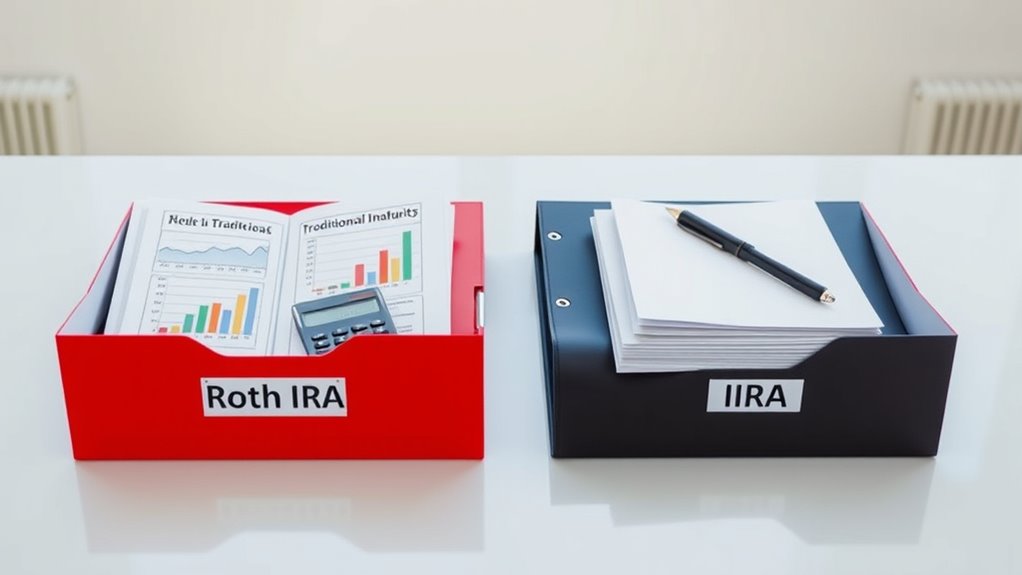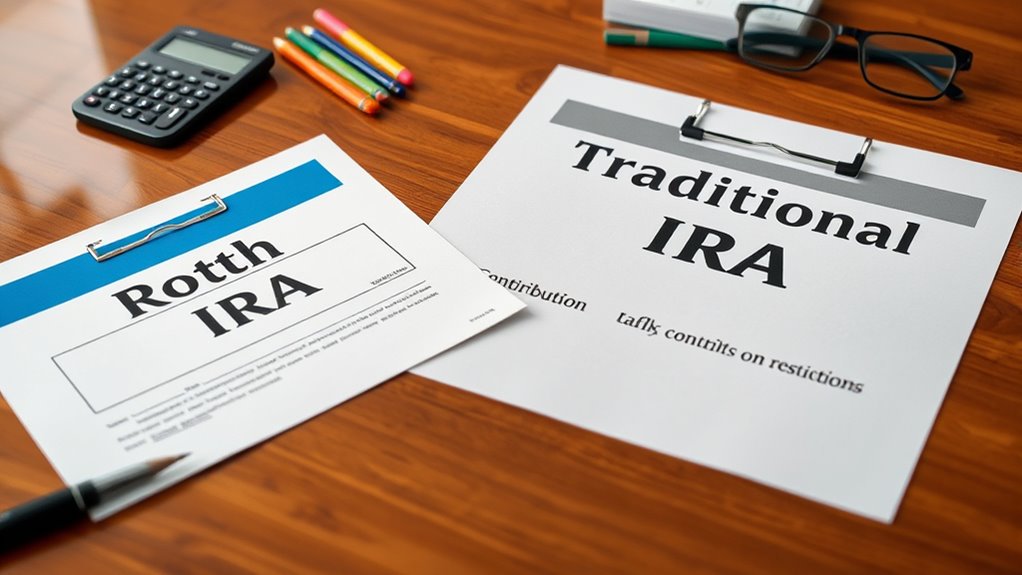To choose between a Roth and traditional IRA, consider your current tax bracket, future income expectations, and retirement goals. If you expect to be in a higher tax bracket later, a Roth might be better because withdrawals are tax-free. If you want immediate tax deductions and lower taxable income now, a traditional IRA suits you. Your eligibility and income also matter. Explore these factors further to find the best match for your finances and future plans.
Key Takeaways
- Consider your current vs. expected future tax brackets to determine if tax deductions now (Traditional) or tax-free growth later (Roth) benefits you more.
- Assess your income level and eligibility; Roth IRAs have income limits, while Traditional IRAs do not.
- Think about your retirement timeline; Roths are ideal for long-term growth, while Traditional IRAs may suit shorter horizons.
- Evaluate your need for withdrawal flexibility; Roth IRAs allow penalty-free contributions and early withdrawals of contributions.
- Match your account choice to your retirement goals and expected income to optimize tax advantages and savings growth.
Understanding the Basic Differences Between Roth and Traditional IRAs

Understanding the basic differences between Roth and Traditional IRAs is essential for making informed retirement savings decisions. With a Roth IRA, you contribute with after-tax dollars, meaning you pay taxes upfront. Your earnings grow tax-free, and qualified withdrawals are also tax-free. In contrast, Traditional IRA contributions are usually made with pre-tax dollars, reducing your taxable income for that year. However, when you withdraw in retirement, those funds are taxed as ordinary income. Both accounts have annual contribution limits—$7,000 for 2025, or $8,000 if you’re over 50—and allow contributions until the tax-filing deadline of the following year. Roth IRAs don’t require minimum distributions, while Traditional IRAs do start RMDs at age 73. The decision between them can significantly impact your tax situation in retirement. These core differences influence how each account fits into your overall retirement plan, especially considering factors like tax implications and future income needs. Additionally, understanding how retirement account rules vary can help you optimize your savings strategy over time. Incorporating knowledge of Gold IRA rollovers and other investment options can further diversify and strengthen your retirement portfolio.
Assessing Your Current and Future Tax Situations

Assessing your current and future tax situations is crucial for choosing the right retirement account. Right now, consider your tax bracket—if you’re in a high bracket, contributing to a Traditional IRA might lower your taxable income with deductions. Conversely, if your income is lower, Roth contributions could be advantageous since they grow tax-free, especially if you expect higher tax rates later. Think about future tax brackets—if you anticipate being in a higher bracket in retirement, Roth accounts offer tax-free withdrawals, while Traditional IRAs might defer taxes better if you expect lower rates. Also, consider potential policy changes and inflation’s impact on your tax situation. Understanding current tax laws and potential changes can further inform your decision-making process. Additionally, evaluating how Bitcoin IRAs and other alternative assets fit into your retirement plan can help optimize your investment strategy for both growth and tax efficiency. Recognizing the importance of tax-advantaged accounts and their role in long-term planning can provide a clearer pathway to achieving your retirement goals.
Evaluating Income Limits and Eligibility Criteria

When considering IRAs, it’s important to know how income limits and eligibility criteria can impact your options. For Roth IRAs, your eligibility depends on your MAGI and filing status. If you’re single and earn less than $150,000 in 2025, you can contribute fully. For joint filers, the limit is $236,000. Income above these thresholds reduces your contribution amount, and if your MAGI exceeds $165,000 (single) or $246,000 (joint), you’re ineligible. Conversely, traditional IRAs have no income restrictions for contributions, but deductibility depends on your income and whether you participate in a workplace plan. Your income level can also influence whether your traditional IRA contributions are tax-deductible or not. Additionally, understanding the role of income limits in retirement planning can help you make more informed decisions. Being aware of retail hours can also be useful when planning your visits to financial institutions or related services. Moreover, considering your current and projected financial situation can assist in selecting the most suitable IRA type for your goals. Always consider your current earnings and future income prospects to determine which IRA aligns with your financial situation and retirement goals.
Considering Your Time Horizon and Retirement Goals

Your time horizon and retirement goals should guide your IRA choice. If you have decades before retirement, a Roth IRA’s tax-free growth can maximize your gains, while a traditional IRA might be better if you’re closer to retiring and expect lower taxes. Thinking about your timeline helps you select the strategy that aligns with your financial future. Traditional IRAs are available to anyone with earned income younger than 70½, which can influence your decision based on your current age and earning potential. Additionally, understanding the state tax implications for IRA withdrawals in your area can help you plan more effectively for retirement income. Considering your investment horizon and how it impacts your retirement savings strategy is also essential in making an informed decision. Staying aware of breakfast delivery trends and options can inspire ideas for nutritious start-of-day meals that support your busy lifestyle.
Retirement Timeline Impact
Choosing between a Roth and a Traditional IRA depends heavily on your retirement timeline and goals. If you’re aiming for short-term savings, a Traditional IRA’s tax-deferred growth can help reduce current taxable income and provide predictable benefits. This suits those planning to retire in a few years or expecting a lower tax bracket then. Conversely, if your goal is long-term growth, a Roth IRA offers tax-free withdrawals and no required minimum distributions, making it ideal for those with decades until retirement. Roths also provide flexibility with penalty-free contributions and withdrawals, which can be advantageous if your timeline shifts. Your long-term or short-term focus should guide your choice, aligning your account type with your specific retirement milestones and tax strategy. Additionally, understanding the contribution limits and income restrictions for each type can help you make an informed decision based on your current financial situation. Considering the hours of operation for various financial institutions can also be useful when planning your contributions or seeking financial advice. Moreover, evaluating the tax implications of each option can further clarify which account best aligns with your projected retirement income and tax bracket. To optimize your strategy, it’s also helpful to explore how digital tools can assist in managing your retirement accounts and tracking progress over time.
Growth Potential Benefits
The growth potential of your IRA depends heavily on your time horizon and retirement objectives. With a longer horizon, you have more time for compound interest to grow your investments, maximizing your returns. Starting early boosts your savings considerably, allowing your money to compound over decades. Roth IRAs offer tax-free growth, which means your earnings grow without being taxed if you meet certain conditions, enhancing your growth potential. Diversifying your investments within the IRA can help manage risks and improve growth prospects. Your risk tolerance also influences how aggressively you invest, impacting overall growth. Additionally, aligning your contributions with your long-term goals ensures you stay on track. Whether you choose Roth or Traditional, understanding how your time frame and goals influence growth helps you optimize your retirement savings strategy. Tax advantages can significantly amplify your investment growth over time. A well-planned strategy considers investment diversification to mitigate risks and enhance potential returns over your investment horizon. Incorporating Personality Traits like patience and discipline can also support consistent contributions and prudent investment choices. Moreover, understanding the driving factors behind growth, such as market conditions and investment selection, can help you make informed decisions for your retirement plan.
Analyzing Contribution Limits and Age Restrictions

Understanding contribution limits and age restrictions helps you plan your retirement savings effectively. Both IRAs have maximum contribution amounts that vary with age, especially after age 50, when catch-up contributions kick in. Keep in mind, your earned income must support your contributions, and these rules differ slightly between Roth and Traditional IRAs.
Contribution Limits by Age
Age plays a significant role in shaping your IRA contribution limits, especially as you approach or surpass 50 years old. If you’re 50 or older, you can add a $1,000 catch-up contribution to the standard $7,000 limit, raising your total to $8,000. This boost helps you save more as retirement nears. Keep in mind, income restrictions still apply for Roth IRA contributions, but age-based catch-up contributions are strictly age-dependent, not income-dependent. To clarify, consider this table:
| Age Group | Standard Limit | Catch-Up Contribution | Total Limit |
|---|---|---|---|
| Under 50 | $7,000 | $0 | $7,000 |
| 50-59 | $7,000 | $1,000 | $8,000 |
| 60+ | $7,000 | $1,000 | $8,000 |
| Under 50 | (Traditional/ Roth) | (Same) | Same |
| 50+ | (Traditional/ Roth) | (Same) | Same |
This structure emphasizes how age influences your contribution potential.
Age Restrictions on Contributions
Contributions to traditional IRAs have no age limits since 2020, allowing you to keep saving regardless of your age. Before then, contributions stopped at age 70½, but now you can contribute as long as you have earned income. There’s no restriction on rollovers, conversions, or transfers, and these don’t count toward contribution limits. For Roth IRAs, there’s also no age limit if you have earned income or a spouse with earned income. You can contribute at any age, but income level may restrict how much you can contribute. Keep in mind, though, that starting at age 73 (in 2024/2025), traditional IRAs require you to begin RMDs, which could impact your contribution strategy. RMD rules still apply to traditional IRAs, requiring withdrawals starting at age 73.
Earned Income Requirements
To contribute to both Roth and Traditional IRAs, you must have earned income, which includes wages, salaries, and self-employment earnings. Your earned income determines your eligibility and contribution limits. In 2025, the contribution limit is $7,000, or $8,000 if you’re age 50 or older. Here’s what you need to know:
- Income Limits: Full Roth contributions are allowed if your modified adjusted gross income (MAGI) is below $150,000 (single) or $236,000 (joint). Partial contributions are phased out between specific income ranges.
- Earned Income Types: Wages, salaries, commissions, self-employment net earnings qualify. Investment income, Social Security, and pensions do not.
- Age Restrictions: You can’t contribute after age 70½ to Traditional IRAs, but Roth contributions are unaffected by age.
Examining Withdrawal Rules and Penalty Implications

Understanding the withdrawal rules and penalty implications for Roth and Traditional IRAs is essential for effective retirement planning. With Roth IRAs, you can withdraw contributions anytime without penalties or taxes, but earnings face penalties if taken early—unless you meet specific exceptions. Traditional IRAs require taxes on withdrawals, and early distributions usually incur a 10% penalty unless an exception applies. RMDs impact Traditional IRAs starting at age 73, while Roth IRAs have no RMDs, offering more flexibility. Here’s a comparison:
| Feature | Roth IRA | Traditional IRA | Common Exception |
|---|---|---|---|
| Contributions | Always accessible, penalty-free | Taxed upon withdrawal | First-time home purchase |
| Earnings | Tax-free after 5-year rule | Taxed as ordinary income | Qualified education expenses |
| Early withdrawal penalty | 10% on earnings, no penalty on contributions | 10% on contributions & earnings | Medical expenses |
| RMDs | None | Required from age 73 | N/A |
Additionally, Roth IRAs can be a powerful tool for estate planning because they allow your heirs to inherit the account with continued tax advantages.
Exploring Strategies for Tax Diversification and Flexibility

Implementing tax diversification strategies can substantially enhance your retirement planning flexibility. By spreading investments across different account types, you gain control over when and how you pay taxes, potentially lowering your long-term tax burden. Here are three key strategies:
Tax diversification enhances retirement flexibility by controlling tax timing and reducing long-term burdens.
- Roth Conversions: Move funds from traditional to Roth accounts to optimize tax timing, especially during low-income years.
- Tax Bracket Management: Contribute to Roth accounts when your income is in a lower tax bracket to maximize benefits.
- Mix of Accounts: Balance contributions between traditional and Roth IRAs based on current and expected future tax rates, providing adaptable income streams in retirement. Tax rates tend to remain stable over the long term, making strategic timing crucial.
These approaches allow you to tailor your withdrawals and minimize taxes, increasing your financial flexibility.
Making an Informed Decision Based on Your Financial Circumstances

Choosing between a Roth and a Traditional IRA depends heavily on your current financial situation and future expectations. If your income falls below the 2025 limits—$150,000 for single filers or $236,000 for joint filers—you might qualify for full Roth contributions, benefiting from tax-free growth. If your income exceeds these thresholds, a backdoor Roth or traditional IRA could be better options. Consider your current tax rate versus expected future rates; Roths are ideal if you expect higher future taxes, while Traditional IRAs suit those in higher current brackets. Age and time horizon matter too: younger investors may prefer Roths for long-term tax-free growth, whereas near-retirees might opt for Traditional IRAs for immediate deductions. Your employment status, estate plans, and withdrawal flexibility also influence the best choice.
Frequently Asked Questions
Can I Contribute to Both Roth and Traditional IRAS Simultaneously?
Yes, you can contribute to both Roth and Traditional IRAs at the same time, but your total contributions can’t exceed the annual limit. For 2024, that’s $7,000 if you’re under 50 or $8,000 if you’re 50 or older. Keep in mind, eligibility for Roth contributions depends on your income, while Traditional IRAs have no income limits for contributions, though deductibility may vary.
How Do Required Minimum Distributions (RMDS) Impact IRA Planning?
Think of RMDs as the tide that gradually erodes your retirement savings if ignored. They require you to withdraw a set amount annually, which can bump your taxable income higher. Planning around RMDs helps you avoid penalties and keeps your financial boat steady. Strategically managing withdrawals, possibly from different accounts, allows you to minimize taxes and maximize your retirement income, ensuring your savings serve you well into the future.
Are There Specific Investment Options Available Within IRAS?
You have a variety of investment options within IRAs. Standard choices include stocks, mutual funds, ETFs, annuities, and cash management accounts for liquidity. If you opt for a self-directed IRA, you can also invest in real estate, private placements, precious metals, loans, and tax liens. Just remember, certain assets like collectibles, life insurance, and S corporations are prohibited, so always check IRS rules before investing.
What Happens if My Income Exceeds Roth IRA Limits?
If your income exceeds Roth IRA limits, you might think your options are gone. But don’t worry—you can still contribute through a backdoor Roth, by first putting money into a traditional IRA and then converting it. Alternatively, consider a traditional IRA or employer-sponsored plans like a 401(k). Staying informed about income thresholds and timing your contributions can keep your retirement savings on track, even when limits are tight.
Can I Convert a Traditional IRA to a Roth IRA Later?
Yes, you can convert a traditional IRA to a Roth IRA later. There are no income restrictions for conversions, so you can do it whenever it fits your financial plan. Keep in mind, the amount you convert is taxed as ordinary income in that year. Consider your current tax bracket and future plans, and consult a financial advisor to optimize your conversion timing and strategy.
Conclusion
Choosing between a Roth and traditional IRA isn’t just about taxes—it’s about shaping your future. While a Roth offers tax-free growth and flexibility, a traditional provides immediate deductions. Your current situation might favor one over the other, but your long-term goals matter most. By weighing these differences now, you set the stage for a retirement that’s both secure and tailored to your needs. Make your choice wisely; your future self will thank you.









